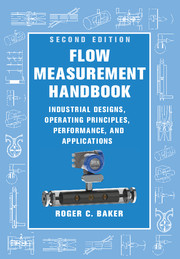Book contents
- Frontmatter
- Dedication
- Contents
- Preface
- Acknowledgements
- Nomenclature
- 1 Introduction
- 2 Fluid Mechanics Essentials
- 3 Specification, Selection and Audit
- 4 Calibration
- 5 Orifice Plate Meters
- 6 Venturi Meter and Standard Nozzles
- 7 Critical Flow Venturi Nozzle
- 8 Other Momentum-Sensing Meters
- 9 Positive Displacement Flowmeters
- 10 Turbine and Related Flowmeters
- 11 Vortex Shedding, Swirl and Fluidic Flowmeters
- 12 Electromagnetic Flowmeters
- 13 Magnetic Resonance Flowmeters
- 14 Ultrasonic Flowmeters
- 15 Acoustic and Sonar Flowmeters
- 16 Mass Flow Measurement Using Multiple Sensors for Single-Phase Flows
- 17 Multiphase Flowmeters 508
- 18 Thermal Flowmeters
- 19 Angular Momentum Devices
- 20 Coriolis Flowmeters
- 21 Probes for Local Velocity Measurement in Liquids and Gases
- 22 Verification and In Situ Methods for Checking Calibration
- 23 Remote Data Access Systems
- 24 Final Considerations
- References
- Main Index
- Flowmeter Index
- Flowmeter Application Index
5 - Orifice Plate Meters
Published online by Cambridge University Press: 05 August 2016
- Frontmatter
- Dedication
- Contents
- Preface
- Acknowledgements
- Nomenclature
- 1 Introduction
- 2 Fluid Mechanics Essentials
- 3 Specification, Selection and Audit
- 4 Calibration
- 5 Orifice Plate Meters
- 6 Venturi Meter and Standard Nozzles
- 7 Critical Flow Venturi Nozzle
- 8 Other Momentum-Sensing Meters
- 9 Positive Displacement Flowmeters
- 10 Turbine and Related Flowmeters
- 11 Vortex Shedding, Swirl and Fluidic Flowmeters
- 12 Electromagnetic Flowmeters
- 13 Magnetic Resonance Flowmeters
- 14 Ultrasonic Flowmeters
- 15 Acoustic and Sonar Flowmeters
- 16 Mass Flow Measurement Using Multiple Sensors for Single-Phase Flows
- 17 Multiphase Flowmeters 508
- 18 Thermal Flowmeters
- 19 Angular Momentum Devices
- 20 Coriolis Flowmeters
- 21 Probes for Local Velocity Measurement in Liquids and Gases
- 22 Verification and In Situ Methods for Checking Calibration
- 23 Remote Data Access Systems
- 24 Final Considerations
- References
- Main Index
- Flowmeter Index
- Flowmeter Application Index
Summary
Introduction
The orifice plate flowmeter, the most common of the differential pressure (DP) flowmeter family, is also one of the most common industrial flowmeters. It is apparently simple to construct, being made of a metal plate with an orifice that is inserted between flanges with pressure tappings formed in the wall of the pipe. It has a great weight of experience to confirm its operation. However, it is far more difficult to construct than appears at first sight, and the flow through the instrument is complex.
Some key features of the geometry of the orifice and of the flow through it are shown in Figure 5.1. The behaviour of the orifice plate may be predicted, but the predictions derive from experimental observation and data. The inlet flow will usually be turbulent and will approach the orifice plate where an upstream pressure tapping (one diameter before the orifice plate) will measure the pressure at the wall, that is in this case the static pressure. (Flange and corner tappings will be discussed later.) The flow close to the orifice plate will converge towards the orifice hole, possibly causing a recirculation vortex around the outside corner of the wall and orifice plate. The inward momentum of the flow at the orifice hole will continue downstream of the hole, so that the submerged jet coming out of the hole will reduce to a smaller cross-section than the hole, which is known as the vena contracta, the narrowest point of the submerged jet. Outside this submerged jet is another larger recirculation zone, and the downstream pressure tapping (the one after the orifice) set in the wall senses the pressure in the vena contracta across this recirculation zone. Downstream of this point, diffusion takes place with considerable total pressure loss.
The data on which the orifice predictions are based may be presented in three ways (cf. Miller 1996):
1. The most accurate method is to use a discharge coefficient-Reynolds number curve for the required geometry, which includes all dimensional effects and other influences.
2. To reduce the number of curves, a datum curve is used in conjunction with correction factor curves. This was essentially the procedure adopted for the British Standard 1042: Part 1:1964.
- Type
- Chapter
- Information
- Flow Measurement HandbookIndustrial Designs, Operating Principles, Performance, and Applications, pp. 116 - 162Publisher: Cambridge University PressPrint publication year: 2016



